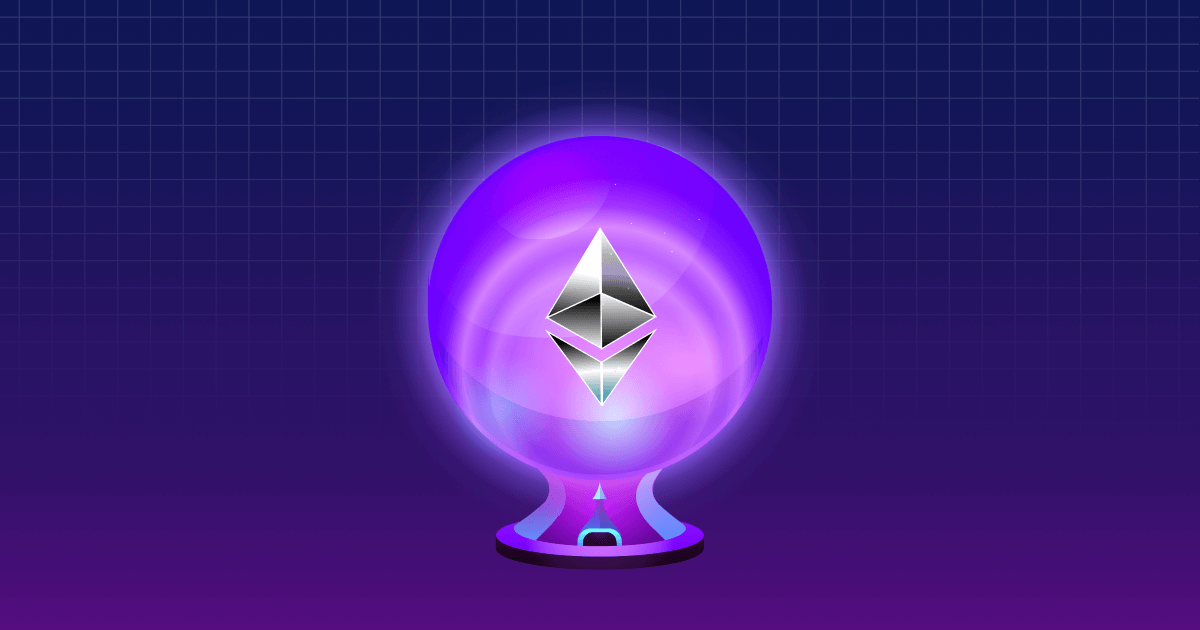
A recent survey by Finder, an analytics platform, has sparked excitement among crypto and fintech enthusiasts with its bold prediction that Ethereum could reach a peak value of $2,500 per token in 2023.
This news will stir up speculation and discussion among those curious about this popular cryptocurrency’s future.
This leads us to the question, “What do experts think about the future of Ethereum?”
To gain some insight into this question, join us as we explore the expert insights that may shape the future of this groundbreaking digital currency.
What is Ethereum?
Ethereum is a blockchain-based, decentralized platform that enables developers to build decentralized applications, or “dApps.” It was created by Vitalik Buterin in 2013 and launched in 2015.
Unlike Bitcoin, which is primarily used as a digital currency, Ethereum is designed to be a platform for creating and executing smart contracts. Smart contracts are self-executing contracts programmed to perform transactions automatically and execute certain conditions when specific criteria are met.
Ethereum also has its own cryptocurrency called Ether (ETH), which is used as a means of payment for transactions on the Ethereum platform. It is currently the second-largest cryptocurrency by market capitalization ($222 Billion), behind only Bitcoin ($531 Billion).
The Ethereum platform has been embraced by developers worldwide for its flexibility and potential to create decentralized applications across various industries, from finance to real estate to gaming.
Its open-source nature and community-driven development have helped to make it one of the most innovative and promising blockchain platforms.
The Evolution of Ethereum
The evolution of Ethereum can be divided into two major phases — Ethereum 1.0 and Ethereum 2.0.
1. Ethereum 1.0
Ethereum 1.0 was the initial version of the Ethereum platform launched in 2015.
This version introduced the concept of smart contracts, allowing developers to build dApps on top of the Ethereum blockchain.
It also introduced the Ethereum Virtual Machine (EVM), which executes smart contracts. The native token of Ethereum is Ether (ETH), which is used to fuel transactions and pay for computational power on the network.
But, Ethereum 1.0 has faced several challenges, including scalability issues and high transaction fees, which have limited its usability and adoption in certain industries.
2. Ethereum 2.0
Ethereum 2.0, or ETH 2.0, is a major upgrade to the Ethereum platform. It addresses the challenges faced by Ethereum 1.0 and improves the network’s scalability, security, and sustainability.
Ethereum 2.0 added the Proof of Stake (PoS) consensus mechanism, which is more energy-efficient and secure than the current Proof of Work (PoW) mechanism.
Other features of Ethereum 2.0 include higher throughput, improved interoperability with other blockchains and better tools for developers to build dApps.
Finder’s Survey Results
The recent survey by Finder, titled “Ethereum Price Predictions,” has garnered much attention from the crypto community. This survey involved 56 experts from the fintech and cryptocurrency industries who shared their opinions on the future of Ethereum.
Most experts predict that Ethereum will reach its peak value of approximately $2500 this year, with an end-of-year value of $2200.
Interestingly, a quarter of the participants believe Ethereum will surpass Bitcoin’s growth rate by 2025. Overall, many experts see a bright future for this cryptocurrency, citing it as the leading platform for smart contracts.
Below are some of the key findings from the survey,
- A significant majority — 60% — believe Ethereum (ETH) is undervalued. This suggests that there is room for growth in cryptocurrency, which is currently the second-largest by market capitalization.
- However, some dissenting opinions still exist, with 12% of participants believing that ETH is overvalued.
- Interestingly, the survey also revealed that 56% of the experts think that now is a good time to buy ETH for a long-term investment, while 28% advise refraining.
Probability of Flippening
Ethereum enthusiasts are eagerly awaiting the “Flippening.”
Coined during the historic 2017 bull run, flippening is a scenario in which the market capitalization of Ethereum’s native token, Ether, surpasses Bitcoin’s.
Despite being a popular topic among crypto enthusiasts, the likelihood and timing of the Flippening remain unclear, as the crypto market is highly volatile and unpredictable.
While the timing of the Flippening remains uncertain, many experts believe in the potential of Ethereum to eventually overtake Bitcoin in market capitalization.
As both cryptocurrencies continue to evolve and attract new investors, it will be interesting to see how this competition unfolds in the coming years.
Expert Insights on the Future of Ethereum
1. Long-Term Potential of Ethereum
According to Ben Ritchie, managing director of Digital Capital Management, Ethereum’s dominance as a leading smart contract platform is a key factor that will contribute to its growth in the future.
Despite the complex market conditions, Ritchie believes that Ethereum’s value will continue to rise.
Josh Fraser, the co-founder of Origin Protocol, highlights Ethereum’s pivotal role in developing decentralized finance (DeFi) and non-fungible tokens (NFTs).
As scaling solutions gain wider adoption, Fraser predicts that Ethereum will be used for applications beyond finance, such as identity verification and social coordination.
If this happens, Fraser believes that Ether’s price could reach six figures, indicating significant growth potential for the cryptocurrency.
2. Interdependence with Bitcoin
Damian Chmiel, a senior analyst and editor at Finance Magnates, believes that the price of Ethereum is closely tied to Bitcoin’s price. In his view, Ethereum’s value will only rebound when Bitcoin’s price rises.
While some experts believe in Ethereum’s long-term potential as a leading smart contract platform, Chmiel’s perspective highlights the current interdependence of the two cryptocurrencies and the impact that Bitcoin’s market movements can have on Ethereum’s price.
3. Increasing adoption of dApps
Sathvik Vishwanath, the CEO and co-founder of Unocoin Technologies Private Limited, is optimistic about the growth of Ethereum. He believes more dApps will be built on its platform.
According to him, as businesses adopt these dApps, the demand for Ethereum will increase, leading to a potential rise in its price.
Conclusion
As we come to the end of our exploration into the future of Ethereum, it’s clear that this digital currency is poised for continued growth and innovation.
From scalability solutions to regulatory hurdles, it’s clear that Ethereum is not without its obstacles. Still, the potential for this technology to transform industries and economies is undeniable.
As we look ahead to the future of cryptocurrency and blockchain technology, it’s clear that Ethereum will remain a key player in the digital landscape. We can’t wait to see what’s next for this revolutionary platform.
FAQs
1. What is Ethereum, and how is it different from Bitcoin?
Ethereum is a decentralized blockchain platform that enables developers to build and deploy decentralized applications (dApps).
It differs from Bitcoin because it serves as a digital currency and provides a platform for creating smart contracts and dApps.
Ethereum uses its own programming language, Solidity, which allows developers to create custom smart contracts to automate complex transactions and processes.
2. What is Flippening?
Coined during the historic 2017 bull run, flippening is a scenario in which the market capitalization of Ethereum’s native token, Ether, surpasses Bitcoin’s.
Despite being a popular topic among crypto enthusiasts, the likelihood and timing of the Flippening remain unclear, as the crypto market is highly volatile and unpredictable.




